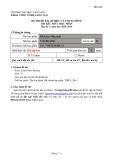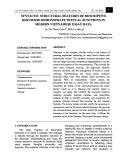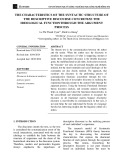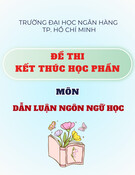
VĂN HÓA https://jst-haui.vn
Tạp chí Khoa học và Công nghệ Trường Đại học Công nghiệp Hà Nội Tập 61 - Số 2 (02/2025)
26
NGÔN NG
Ữ
P
-
ISSN 1859
-
3585
E
-
ISSN 2615
-
961
9
SINO-VIETNAMESE MORPHEMES:
THEIR GRAMMATICAL BEHAVIOUR AND IMPLICATIONS
FOR SEMANTICS AND PHONETICS
ỨNG XỬ NGỮ PHÁP CỦA HÌNH VỊ HÁN VIỆT VÀ HỆ QUẢ CỦA NÓ VỀ NGỮ NGHĨA VÀ NGỮ ÂM
Hoang Dzung1,*
DOI: http://doi.org/10.57001/huih5804.2025.033
ABSTRACT
This paper shows that Sino-Vietnamese morphemes combine not only with other Sino-Vietnamese morphemes but also with non-Sino-
Vietnamese
morphemes, such as native Vietnamese and even Indo-European elements, particularly French loanwords. This phenomenon is
not unique to Vietnamese: similar
hybrid words can also be found in other Sino-xenic languages (Japanese and Korean) as well as Indo-European languages. In noun phrases where the Sino-
Vietnamese morpheme serves as the head, the Chinese grammatical rule [modifier + head] tends to predominate, but in some case
s, Vietnamese follows its
native grammatical structure [head + modifier]. This grammatical behaviour has semantic consequences
. Indeed, the criterion [± interchangeable in all
contexts], used to classify synonyms into “absolute synonyms” and “non-absolute synonyms,” proves ineffective, because free Sino-
Vietnamese morphemes can
combine with both other Sino-Vietnamese morphemes an
d native Vietnamese ones, whereas their native Vietnamese synonyms generally cannot combine with
Sino-Vietnamese morphemes. The differences in combinability of Sino-
Vietnamese morphemes lead to semantic consequences in connection with phonology:
Sino-Vietnamese morphemes with very low productivity tend to be assimilated into (near-)homophonous morphemes - whether Sino-Vietnamese or non-Sino-
Vietnamese - with higher productivity.
Keywords: Grammatical behaviour, hybrid word, loanword, Sino-Vietnamese, Sino-xenic.
TÓM TẮT
Bài báo cho thấy hình vị Hán Việt không chỉ kết hợp với hình vị Hán Việt khác, mà còn với hình vị phi Hán Việt như thuần Việt và thậm chí cả các hình vị Ấn -
Âu,
đặc biệt là mượn tiếng Pháp. Đây không phải là hiện tượng riêng của tiếng Việt: những từ lai tương tự cũng có thể được tìm thấy trong các ngôn ngữ Sino-
xenic khác
(Nhật, Hàn) và các ngôn ngữ Ấn - Âu. Trong danh ngữ có hình vị Hán Việt đóng vai trò chính, chiếm ưu thế là quy tắc ngữ pháp tiếng Hán [phụ + chính] nhưng c
ũng
có khi tiếng Việt lại áp dụng quy tắc ngữ pháp tiếng Việt [chính + phụ]. Đặc điểm ngữ pháp này đưa đến hệ quả về ngữ nghĩa. Quả vậy, tiêu chí [± có thể hoán đổ
i
trong mọi ngữ cảnh] dùng để phân loại từ đồng nghĩa thành “đồng nghĩa tuyệt đối” và “đồng nghĩa không tuyệt đối” là không hiệu quả vì các hình vị Hán Việt tự
do
có thể kết hợp với cả hình vị Hán Việt khác lẫn hình vị thuần Việt, trong khi các từ đồng nghĩa thuần Việt của chúng thường không thể kết hợp với hình vị Hán Việt. S
ự
khác biệt về khả năng kết hợp của hình vị Hán Việt đưa đến hệ quả về phương diện ngữ nghĩa trong mối liên quan với ngữ âm: những hình vị Hán Việt có sức sả
n sinh
quá yếu sẽ có xu hướng bị đồng nhất vào những hình vị (Hán Việt hay phi Hán Việt) đồng âm hay gần âm có sức sản sinh mạnh.
Từ khóa: Ứng xử ngữ pháp, từ lai, từ mượn, Hán Việt, Sino-xenic.
1HCMC Linguists' Society, Vietnam
*Email: dunghoang07@gmail.com
Received: 18/01/2025
Revised: 22/02/2025
Accepted: 27/02/2025
1. INTRODUCTION
After Khúc Thừa Dụ’s proclamation of autonomy (906
CE) and the victory of Ngô Quyền (938 CE), the Chinese
language in Vietnam began to separate from the Chinese
language in China. Now following its own path, it
gradually became phonetically, semantically and

P-ISSN 1859-3585 E-ISSN 2615-9619 https://jst-haui.vn LANGUAGE - CULTURE
Vol. 61 - No. 2 (Feb 2025) HaUI Journal of Science and Technology
27
grammatically distinctive, culminating in Sino-
Vietnamese (see [13]) (To be distinguished from Old Sino-
Vietnamese and Vietnamized Sino-Vietnamese [12]). Due
to its significant role in the history of Vietnamese
language, Sino-Vietnamese has long attracted the
attention of experts [7, 12]. However, most studies on
Sino-Vietnamese have focused on its phonetics or
lexicon, and have been less interested in its grammatical
behaviour.
This paper focuses on investigating the combinatory
possibilities of Sino-Vietnamese morphemes, from which
their semantic, and sometimes also phonetic, impacts can
be examined. Our interest is thus in the syntax-semantics-
phonetics interface of Sino-Vietnamese elements.
2. GRAMMAR OF SINO-MORPHEME COMBINATIONS
A common view among non-experts is that the only
acceptable morphemic combination is [Sino-Vietnamese
+ Sino-Vietnamese] (An example is the following claim:
“Tặc [
賊
literally ‘thief, pirate, invader’] is chữ nho ‘Chinese
element(s)’, hence it should be combined with another chữ
nho (lâm tặc; lâm
林
meaning ‘forest’); combining chữ nho
with chữ nôm ‘Vietnamese element(s)’ (e.g., cát tặc ‘sand
thief’) is not accurate (sa tặc is correct [sa
沙
‘sand’]).” [3].
This is a typical manifestation of the tendency to venerate
linguistic purity, while overlooking the existence of the
considerable amount of data from modern Vietnamese
that attests otherwise.
Indeed, it is easy to find [non-Sino-Vietnamese + Sino-
Vietnamese] noun phrases in which the head is final (Học
trò [literally ‘(school) pupil’ is an exception, as the pure
Vietnamese morpheme is the phrasal head yet is word-final
as if it were pure Sino-Vietnamese. The cause perhaps
originated in history: trò and đồ
徒
‘learner’ are cognates,
but the former is Old Sino-Vietnamese. In other words, học
trò was used before the Tang dynasty. Note that Old Sino-
Vietnamese and Vietnamized Sino-Vietnamese are both
classified as ‘pure Vietnamese’ from the standpoint of
synchronic etymology).
The non-Sino-Vietnamese morpheme may be pure
Vietnamese (henceforth simply Vietnamese), as seen in
bếp trưởng ‘head chef’ (Vietnamese bếp ‘cook’ + Sino-
Vietnamese trưởng 長 ‘chief’), chuyền trưởng ‘line
manager (in a factory)’ (Vietnamese chuyền ‘[factory] line’
+ Sino-Vietnamese ‘chief’), cửa hàng trưởng ‘store
manager’ (Vietnamese cửa hàng ‘store’ + Sino-
Vietnamese trưởng ‘chief’), máy trưởng ‘chief engineer’
(Vietnamese máy ‘machine’ + Sino-Vietnamese trưởng
‘chief’), nhóm trưởng ‘group leader’ (Vietnamese nhóm
‘group’ + Sino-Vietnamese trưởng ‘chief’), quầy trưởng
‘kiosk chief’ (Vietnamese quầy ‘kiosk’ + Sino-Vietnamese
trưởng ‘chief’), xóm trưởng ‘head of a neighborhood’
(Vietnamese xóm ‘neighborhood’ + Sino-Vietnamese
trưởng ‘chief’),… xoắn trùng / xoắn khuẩn ‘spirochaete
bacteria’ (Vietnamese xoắn ‘spiral’ + Sino-Vietnamese
trùng 蟲 ‘strain’/ khuẩn 菌 ‘bacteria’), phẩy trùng / phẩy
khuẩn ‘vibrio bacteria’ (Vietnamese phẩy ‘comma’ + Sino-
Vietnamese trùng ‘strain’/ khuẩn ‘bacteria’).
While some [Sino-Vietnamese + Sino-Vietnamese]
noun phrases such as hải tặc ‘pirate’ (hải 海 ‘sea’ + tặc 賊
‘invader’), không tặc ‘hijacker’ (không 空 ‘air’ + tặc ‘invader’),
sơn tặc ‘mountain highwaymen’ (sơn 山 ‘mountain’ + tặc
‘invader’) and thuỷ tặc ‘river pirate’ (thuỷ 水 ‘water’ + tặc
‘invader’) consist of the morpheme tặc (‘invader’) with the
preceding element indicating the spatial domain in which
the invader acts (hải tặc ‘invader [acting at] sea’, không tặc
‘invader [acting in the] air (= in an aeroplane)’, sơn tặc
“invader [acting on a] mountain”, thuỷ tặc “invader [acting
on] water (= on a river)’), we have recently witnessed the
emergence of [Vietnamese + Sino-Vietnamese] noun
phrases, whose initial morphemes no longer depict a
domain of activity, but instead an object of theft: (Note that
the combination [Sino-Vietnamese + tặc] can exist
simultaneously with the [pure Vietnamese + tặc] variant: cf.
cá tặc versus ngư tặc ‘fish thief’ (ngư
魚
‘fish’); cát tặc versus sa
tặc ‘sand thief’ (Người lao động 6/4/2013); chó tặc versus cẩu
tặc ‘dog thief’ (cẩu
狗
‘dog’) (Đất Việt 20/09/2013); đất tặc
versus thổ tặc ‘land robber’ (thổ
土
‘land’) (dantri.com
27/02/2011); kiểng tặc versus cảnh tặc ‘bonsai plant thief’
(cảnh
境
literally ‘scenery’) (Nông nghiệp Việt Nam,
24/4/2012), trâu tặc versus ngưu tặc ‘buffalo thief’ (ngưu
牛
‘buffalo’); vàng tặc versus kim tặc ‘gold thief’ (kim
金
‘gold’)
(Sài Gòn tiếp thị 8/12/2011). The usage [pure Vietnamese +
tặc] is still not convincing for many people: “Why can [they]
say cát tặc ‘sand thief’, but not giặc cát while we have giặc đói
‘hunger crisis’, giặc dốt ‘illiterate crisis’, giặc châu chấu
‘grasshopper crisis’, and so forth; why do [they] use đất tặc
‘land robber’ but not (bọn) cướp đất […] I believe that we
should not be tolerant here; we should instead provide
guidance.” (An Chi, personal communication) bò tặc ‘cow
thief’, cà tặc ‘coffee bean thief’ (cà is an abbreviation of cà
phê ‘coffee'), chim tặc ‘bird thief’ (Công an TP Đà Nẵng
15/8/2013), dầu tặc ‘oil thief’, dế tặc ‘cellphone thief’ (dế
literally ‘cricket’, a slang for cellphone), dưa tặc ‘melon
thief’, dừa tặc ‘coconut thief’ (Lao động 08/02/2013), đá tặc
‘stone thief’, gà tặc ‘chicken thief’, gạch tặc ‘brick thief’, mai
tặc ‘apricot blossom thief’, mèo tặc ‘cat thief’, nghêu tặc

VĂN HÓA https://jst-haui.vn
Tạp chí Khoa học và Công nghệ Trường Đại học Công nghiệp Hà Nội Tập 61 - Số 2 (02/2025)
28
NGÔN NG
Ữ
P
-
ISSN 1859
-
3585
E
-
ISSN 2615
-
961
9
‘clam thief’ (Tuổi trẻ 25/4/2012), rùa tặc ‘turtle thief’, sưa tặc
‘thief of Dalbergia bouruana gagu trees’, than tặc ‘coal
thief’, thiếc tặc ‘tin thief’ (Người lao động, 11/8/2013), tôm
tặc ‘shrimp thief’, xe tặc ‘vehicle thief’, and so on (It may be
necessary to include a special case in which the first element
depicts a body part under attack: mông tặc (Vietnamese
mông ‘buttocks’ + Sino-Vietnamese tặc ‘invader’)
(vnexpress.net 25/5/2005) is a person who sticks kim ‘needle’
(kim tặc, Cao Phi Yến [3] – homonymous to kim tặc, whose
meaning is equivalent to vàng tặc ‘gold robber/thief’) into
women’s buttocks!).
There are also cases in which the first element
indicates the instrument used by the actor: bùn tặc
(Vietnamese bùn ‘mud’ + Sino-Vietnamese tặc ‘invader’),
rác tặc (Vietnamese rác ‘garbage’ + Sino-Vietnamese tặc
‘invader’), bụi tặc (Vietnamese bụi ‘dust’ + Sino-
Vietnamese tặc ‘invader’) are not those who steal mud,
garbage, or dust, but rather who pollute the environment
by spilling mud, garbage, or producing dust; khoan tặc
(Vietnamese khoan ‘drill’ + Sino-Vietnamese tặc ‘invader’)
is a person who damages the aesthetic of public spaces
by illegally advertising with the slogan Khoan, cắt bê tông
(‘Concrete cutting and drilling’); cào tặc (Vietnamese cào
‘rake’ + Sino-Vietnamese tặc ‘invader’) is a person who
illegally dredges fish; câu tặc (Vietnamese câu ‘angling’ +
Sino-Vietnamese tặc ‘invader’) is a fisherman who uses a
rod to steal fish owned by others; lửa tặc (Hoả tặc ‘fire
breakouts’, the [Sino-Vietnamese + tặc] counterpart of lửa
tặc, does not have the same meaning. In hoả tặc [Sino-
Vietnamese hoả
火
‘fire’ + Sino-Vietnamese tặc ‘invader’],
the morpheme tặc is used metaphorically to mean a danger:
“68% of the warehouses have been completely equipped
with lightning rod sensors which readily cope with hoả tặc
in the dry season.” (Quân đội Nhân dân 13/10/2008))(Giáo
dục, 4/3/2011) is a person who assaults others by burning
them (Examples of [X + tặc] combinations here are from Lê
Minh Hoàng [8] unless indicated otherwise).
Yet another case of [Vietnamese + Sino-Vietnamese]
noun phrases is the [Vietnamese + quán 館 literally ‘shop’]
combination, which appears more widespread every day
across Vietnam in restaurant names: Ba Miền quán
(Vietnamese ba ‘three’ + Vietnamese miền ‘region’ + Sino-
Vietnamese quán ‘shop’), Cây Sung quán (Vietnamese cây
‘tree’ + Vietnamese sung ‘Ficus racemosa’ + Sino-
Vietnamese quán ‘shop’), Cây Đa quán (Vietnamese cây
‘tree’ + Vietnamese đa ‘Ficus bengalensis’ + Sino-
Vietnamese quán ‘shop’), Lò Đất quán (Vietnamese lò
‘stove’ + Vietnamese đất ‘earth, soil, land’ + Sino-
Vietnamese quán ‘shop’), Miền Trung quán (Vietnamese
miền ‘region’ + Sino-Vietnamese trung 中 ‘central
[Vietnam]’ + Sino-Vietnamese quán ‘shop’), Sông Trăng
quán (Vietnamese sông ‘river’ + Vietnamese trăng ‘moon’
+ Sino-Vietnamese quán ‘shop’). This construction adds
nuance to restaurants’ names and makes an impression
on the customers.
The non-Sino-Vietnamese morpheme may also be
Indo-European. Many of these combinations have
become popular: băng trưởng ‘gangleader’
(dantri.com.vn 29/3/2012) (băng < French bande ‘gang’),
ca trưởng ‘shift manager’ (ca < French quart ‘quarter’), kíp
trưởng ‘team manager’ (kíp < French équipe ‘team’) (Quán
‘shop’ and trưởng ‘chief’ are both free morphemes. As
such, in addition to the [non-Sino-Vietnamese +
Vietnamese] combination, they can form [Sino-
Vietnamese + non-Sino-Vietnamese] constructions (e.g.
nhóm trưởng / trưởng nhóm ‘head of a group’, ca trưởng /
trưởng ca ‘shift manager’; Cây Sung Quán / Quán Cây Sung
‘a restaurant name’); cồn kế ‘alcoholmeter’ (cồn < French
alcool ‘alcohol’; kế 計, literally ‘count’) (The [Vietnamese
+ Sino-Vietnamese] equivalent here is rượu kế
(Vietnamese rượu ‘wine’ + Sino-Vietnamese kế ‘meter’)),
vôn kế ‘voltmeter’, ămpe kế ‘Ampere meter (ammeter)’,
ohm kế ‘ohmmeter’; cà phê tặc ‘coffee bean thief’ (cà phê
< French café), cao su tặc ‘rubber thief’ (cao su < French
caoutchouc); game thủ ‘gamer’ (thủ 手, literally ‘hand’), cơ
thủ ‘billiards player’ (cơ < French queue
‘cue’)(Monosyllabic Indo-European words are perceived
by Vietnamese speakers as (pure) Vietnamese, as long as
they do not include exotic phonemes (or written
characters). For example, while Vietnamese usually
consider a-xít (< acide), a-mi-ăng (< amiante), a-míp (<
amibe), bê-rê (< beret), bu-gi (< bougie), rô-nê-ô (< ronéo)
and ô-liu (< olive) as ‘Western words’, tem (< timbre
‘stamp’), xăng (< essence ‘gasoline’), kem (< crème
‘cream’), xi (< cire ‘wax’), săm (< chambre (à air) ‘tire tube’,
lốp (< enveloppe) are easily thought of as Vietnamese,
though all were borrowed from French. The case of cà phê
‘coffee’ is exceptional: due to homonymy, numerous
Vietnamese speakers believe the cà in this word to be the
same as the cà of cà chua ‘tomato’, i.e. coffee is a type of
cà. Evidence is that people living in the Vietnamese
Central Highlands (a region known for coffee plantations)
often use cà to refer to coffee in a clear context); logic học
‘logic’ (học 學 ‘study’), robot học ‘robotics’, topo học
‘topology’, virus học ‘virology’(In these listed [modifier +
head] noun phrases, học is a nominal bound morpheme. It

P-ISSN 1859-3585 E-ISSN 2615-9619 https://jst-haui.vn LANGUAGE - CULTURE
Vol. 61 - No. 2 (Feb 2025) HaUI Journal of Science and Technology
29
can be a free morpheme only in the role of a verb. Hence, it
is impossible for [Sino-Vietnamese + non-Sino-Vietnamese]
synonyms to exist, unlike the case of quán or trưởng).
Thus far, [non-Sino-Vietnamese + Sino-Vietnamese]
noun phrases are limited to the following few
morphemes: kế ‘meter’, quán ‘shop’, học ‘study’, khuẩn
‘bacteria’ / trùng ‘strain’, tặc ‘invader’, thủ ‘hand’, trưởng
‘chief’.
It can be observed that in all examples above, the
phrasal head is always Sino-Vietnamese and comes last,
following the structure of Chinese noun phrases, while
the preceding modifier may be non-Sino-Vietnamese.
Hence, here, Vietnamese use Chinese noun phrase
structure rather than Chinese words. This is a case of
borrowing grammatical structure and has so far been
little noticed (Discussing grammatical borrowing of Sino-
Vietnamese, M. J. Alves [1, 2], for instance, focuses only on
functional words with Chinese origins, numerals, and
comparatives, rather than on structural borrowing itself).
Notably, some have pushed this usage much further, as
seen in nữ nhà văn ‘female prose writer’ (Sino-Vietnamese
nữ 女 ‘female’ + Vietnamese nhà ‘person’ + Sino-
Vietnamese văn 文 ‘literature’) (Thanh niên, 17/3/2013) or
nữ cây bút ‘female writer’ (Sino-Vietnamese nữ ‘female’ +
Vietnamese cây [classifier for tree-like objects] + Sino-
Vietnamese bút 筆 ‘pen’) (Công an, 24/3/2013). These
examples show a structural mixture between Vietnamese
noun phrases ([head + modifier]: nhà + văn, cây + bút) and
Chinese noun phrases ([modifier + head]: nữ + [nhà văn],
nữ + [cây bút]). This combination has thus far been viewed
as unacceptable.
Nevertheless, not all noun phrases containing Sino-
Vietnamese elements show a [modifier + head] structure
in which the head is occupied by the Sino-Vietnamese
morpheme. We also find cases with [head + modifier]
word order (the typical noun phrase structure in
Vietnamese), where the modifier position is filled by a
bound Sino-Vietnamese morpheme while the head is
Vietnamese: (If they are free Sino-Vietnamese morphemes
(like học in bàn học ‘desk’), they are in fact counted as pure
Vietnamese) thuỷ ‘water’ in nước thuỷ (Vietnamese nước
‘water’ + Sino-Vietnamese thuỷ ‘water’) (the thin layer of
mercury in a mirror), lính thuỷ ‘marine’ (Vietnamese lính
‘soldier’ + Sino-Vietnamese thuỷ ‘water’), máy thuỷ ‘motor
(for boats)’ (Vietnamese máy ‘machine’ + Sino-
Vietnamese thuỷ ‘water’), tàu thuỷ ‘ship’ (Vietnamese tàu
‘vessel’ + Sino-Vietnamese thuỷ ‘water’); hoả in dầu hoả
‘kerosene’ (Vietnamese dầu ‘oil’ + Sino-Vietnamese hoả
火 ‘fire’), tàu hoả ‘train’ (Vietnamese tàu ‘vessel’ + Sino-
Vietnamese hoả ‘fire’).
The phenomenon is not without a trace in the
Vietnamese verb phrase. The [X + hoá 化 ‘to transform’]
construction which conforms to Chinese grammatical
structure, but in which X is non-Sino-Vietnamese, has
become popular: cứng hoá ‘to harden’ (Vietnamese cứng
‘hard’ + Sino-Vietnamese hoá ‘to transform’), lành mạnh
hoá ‘to purify (metaphorically)’ (Vietnamese lành mạnh
‘wholesome, sound’ + Sino-Vietnamese hoá ‘to
transform’), mềm hóa ‘to soften’ (Vietnamese mềm ‘soft’ +
Sino-Vietnamese hoá ‘to transform’), môi hoá ‘to labialize’
(Vietnamese môi ‘lip’ + Sino-Vietnamese hoá ‘to
transform’), mũi hoá ‘to nasalize’ (Vietnamese mũi ‘nose’ +
Sino-Vietnamese hoá ‘to transform’), ngói hoá ‘to tile [a
roof, etc]’ (Vietnamese ngói ‘tile’ + Sino-Vietnamese hoá
‘to transform’), vôi hoá ‘to calcify’ (Vietnamese vôi ‘lime
(material)’ + Sino-Vietnamese hoá ‘to transform’), xát hoá
‘to fricativize’ (Vietnamese xát ‘to rub’ + Sino-Vietnamese
hoá ‘to transform’). Multi-element examples include a xít
hoá (a xít < French acide ‘acid’), bê tông hoá (bê tông <
French béton ‘concrete’), xi măng hoá (xi măng < French
ciment ‘cement’).
The examples mentioned above are all in subordinate
compound structures. In coordinate compound
structures, we can also observe bound Sino-Vietnamese
morphemes combining with their Vietnamese synonyms
or near-synonyms in noun phrases and verb/adjective
ones: binh lính (兵) lính ‘soldiers’), ẩm thấp (濕 thấp = ẩm
‘damp’), bao (bao 勹) gồm ‘to consist of’, bao (勹) bọc ‘to
wrap/cover’, biến (變) đổi ‘to change’, bồi (培) đắp ‘to
accrete’, kỳ (奇) lạ ‘mysterious/strange’, mũ mão (帽 mão
or mạo [4] and [17] give the mạo reading, while Phan Văn
Các [15] accepts both mạo and mão) = mũ ‘hat’), nuôi
dưỡng (養) ‘to raise’, sinh (生) sống ‘to live’, among others.
3. HYBRID WORDS IN SINO-XENIC LANGUAGES AND
BEYOND
Hybrid words are not confined to Vietnamese; they
can also be found in other Sino-xenic languages (The term
is due to Martin [9] to refer to languages with a lexicon
showing widespread, systematic Chinese borrowing; -xenic
originates from Greek xénos ‘foreign’) such as Japanese or
Korean.
In Japanese, (pure) Japanese morphemes may
combine with non-Japanese elements. Sino-Japanese
(on’yomi) examples include [pure Japanese + Sino-
Japanese] 場 所 basho ‘place’, 湯 桶 yutō ‘hot water

VĂN HÓA https://jst-haui.vn
Tạp chí Khoa học và Công nghệ Trường Đại học Công nghiệp Hà Nội Tập 61 - Số 2 (02/2025)
30
NGÔN NG
Ữ
P
-
ISSN 1859
-
3585
E
-
ISSN 2615
-
961
9
bucket’; [Sino-Japanese + pure Japanese] 金 色 kin’iro
“yellow”, 重 箱 jūbako ‘food box’; [pure Japanese + Sino-
Japanese + Sino-Japanese] 合 気 道 aikidō ‘aikido’. Indo-
European examples include [Japanese + Indo-European]
カラオケ karaoke (Japanese kara ‘empty’ + English oke <
orche(stra)); [Indo-European + Japanese] シャボン玉
shabondama ‘soap bubble’ (shabon < Portuguese
sabão ‘soap’ + Japanese dama < tama ‘bubble’). There are
also cases of [Indo-European + Sino-Japanese] as in ハン
チング帽 hanchingu-bō ‘hunting cap’ (hanchingu <
English hunting + Sino-Japanese bō ‘cap’).
Korean is similar. Sino-Korean + (pure) Korean
constructions are seen, for instance, in 공부하다
kongpuhata ‘to learn’ (Sino-Korean kongu ‘to learn’ +
Korean hata ‘to do’), 행복하다 hengpokhata ‘happy’
(Sino-Korean hengpok ‘happy’ + Korean hata ‘to do’),
다행이다 tahengita ‘lucky’ (Sino-Korean taheng ‘relief’ +
Korean ita ‘to be’). Examples of [Indo-European + pure
Korean] include 메리추석 Merry Chuseok ‘Happy Mid-
autumn’ (English merry + Korean Chuseok ‘Mid-autumn’),
굿밤 gutbam ‘goodnight’ (gut < English good + Korean
bam ‘night’), 방울토마토 bangultomato ‘cherry tomato’
(Korean bangul ‘drop (of water)’ + English tomato), 비닐
봉투 binilbongtu ‘plastic bag’ (binil < English vinyl +
Korean bongtu ‘bag’).
Hybrid words are also common in Indo-European
languages. English, for instance, has many words of Greek
and Latin origin, which may sometimes show hybrid
forms: cf. homosexual (< Greek homos + Latin sexus),
hypercorrection (< Greek hyper + Latin correction),
metadata (< Greek meta + Latin data); sociology (< Latin
socius + Greek logos), television (< Greek tēle + Latin visio).
As in Vietnamese, English allows the parallel existence of
both hybrid and non-hybrid synonyms, cf. aquaphobia (<
Latin aqua + Greek phobos) versus hydrophobia (< Greek
hydro + Greek phobos), monolingual (< Greek monos +
Latin lingua) versus unilingual (< Latin uni + Latin lingua),
and divalent (< Greek di- + Latin valentem) versus bivalent
(< Latin bi- + Latin valentem).
Thus, hybrid words are a universal phenomenon. It is
fair to say that where there is language contact, we find
hybridization; it is as hard to imagine a language without
hybrid words as it is to think of a language without
contact with other languages.
4. TWO TYPES OF GRAMMATICAL BEHAVIOUR IN
VIETNAMESE HYBRID WORDS
Why do hybrid words assert themselves so strongly
puristic criticisms, no matter how furious, fail to stop their
advance? With respect to structure, in order to explain
their existence, it is crucial to keep in mind the following
well-known quote from Ferdinand de Saussure: “La
synchronie ne connaît qu’une perspective, celle des
sujets parlants […]” [16].
Indeed, native speakers do not need to know the
history of their language. For them, the only reality is
synchronic. From the perspective of synchronic
etymology, Vietnamese perceive free Sino-Vietnamese
morphemes in [head + modifier] noun phrases as if they
were pure Vietnamese morphemes, therefore there is no
difference between [Vietnamese + Sino-Vietnamese] and
[Vietnamese + Vietnamese] combinations. Examples
include bàn học ‘desk’ (pure Vietnamese bàn ‘table’ +
Sino-Vietnamese học 學 ‘to learn, to study’) versus bàn ăn
‘dining table’ (pure Vietnamese bàn ‘table’ + Vietnamese
ăn ‘eat’); hòn ngọc ‘gem’ (Vietnamese hòn ‘roundish
(object)’ + Sino-Vietnamese ngọc 玉 ‘gem’) versus hòn đất
‘a ball of soil’ (Vietnamese hòn ‘roundish (object)’ +
Vietnamese đất ‘earth, soil, land’); máy ảnh ‘camera’
(Vietnamese máy ‘machine’ + Sino-Vietnamese ảnh 影
‘image’) versus máy may ‘sewing machine’ (Vietnamese
máy ‘machine’ + Vietnamese may ‘to sew’); người bệnh
‘patient’ (Vietnamese người ‘human’ + Sino-Vietnamese
bệnh 病 ‘illness’) versus người lành ‘healthy person’
(Vietnamese người ‘human’ + Vietnamese lành ‘healthy /
recovered’); nỗi khổ ‘misery’ (Vietnamese nỗi ‘feeling’ +
Sino-Vietnamese khổ 苦 ‘misery’) versus nỗi buồn ‘grief’
(Vietnamese nỗi ‘feeling’ + Vietnamese buồn ‘sad’); tàu
điện ‘electric train’ (pure Vietnamese tàu ‘vessel’ + Sino-
Vietnamese điện 電 ‘electric’) or tàu hỏa (pure Vietnamese
tàu ‘vessel’ + Sino-Vietnamese hỏa 火 ‘fire’) versus tàu lửa
‘train’ (Vietnamese tàu ‘vessel’ + pure Vietnamese lửa
‘fire’); thuốc bổ ‘tonic’ (Vietnamese thuốc ‘medicine’ +
Sino-Vietnamese bổ 補 ‘tonic’) versus thuốc ho ‘cough
medicine’ (pure Vietnamese thuốc ‘medicine’ +
Vietnamese ho ‘cough’); vòng đồng ‘copper bracelet’
(Vietnamese vòng ‘bracelet’ + Sino-Vietnamese đồng 銅
‘copper’) versus vòng đá ‘stone bracelet’ (Vietnamese
vòng ‘bracelet’ + Vietnamese đá ‘stone’); vết thương
‘wound’ (Vietnamese vết ‘mark’ + Vietnamese thương 傷
‘hurt’) versus vết mổ ‘surgical scar’ (Vietnamese vết ‘mark’
+ Vietnamese mổ ‘to operate (surgically)’) (The following
claim by Jae Jung Song [6] regarding Sino-Korean is also
applicable to these Sino-Vietnamese words: “Arguing
that Sino-Korean words are loanwords is like arguing that
English words based on Latin and Greek elements are
loanwords. Native English speakers, unless they are











![Bộ câu hỏi trắc nghiệm Văn bản tiếng Việt [chuẩn nhất]](https://cdn.tailieu.vn/images/document/thumbnail/2025/20251127/thuynhung051106@gmail.com/135x160/24021764296609.jpg)


![Bài giảng Ngôn ngữ học đối chiếu Nguyễn Ngọc Chinh [PDF]](https://cdn.tailieu.vn/images/document/thumbnail/2025/20251101/vovu03/135x160/7471762139652.jpg)







![Ngân hàng câu hỏi môn Tiếng Việt thực hành [chuẩn nhất]](https://cdn.tailieu.vn/images/document/thumbnail/2025/20251003/kimphuong1001/135x160/21861759464951.jpg)
![Bài giảng Văn học phương Tây và Mỹ Latinh [Tập hợp]](https://cdn.tailieu.vn/images/document/thumbnail/2025/20251003/kimphuong1001/135x160/31341759476045.jpg)


